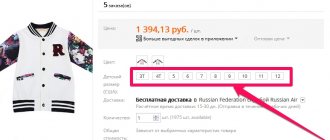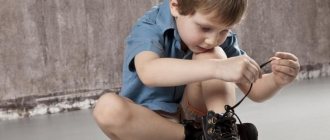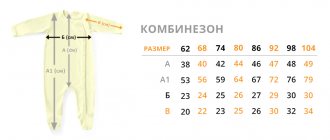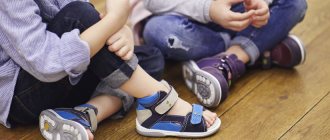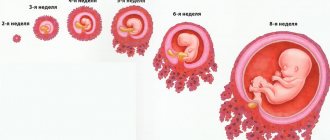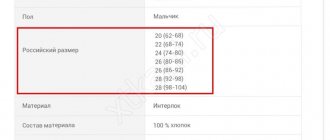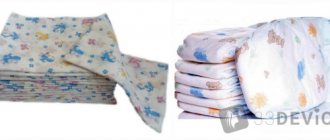How to determine your child's clothing size
Sometimes manufacturers use different criteria to designate the sizes of children's products, so we also indicate the age of the child.
- Cloth. To choose the right clothing size for children, you can use the following indicators: height (in cm) and age
- Shoes. The table also indicates the size according to age.
Children under 1 year
Double size step
CHILDREN'S CLOTHING SIZE CHART.
Correspondence to the height and weight of the child.
CHILDREN'S CLOTHING SIZE CHART
Leg length from waist
CONFORMITY OF RUSSIAN AND EUROPEAN SIZES OF CHILDREN'S CLOTHING.
Chest circumference, cm
Waist circumference, cm
Hip circumference, cm
Arm length to wrist, cm
Side seam length (to the floor), cm
The table below gives approximate sizes for children from 2 to 10 years old.
APPROXIMATE SIZES BY AGE.
Waist circumference, cm
Chest circumference, cm
APPROXIMATE SIZES OF BABY CLOTHES.
If you need help in choosing, our specialists will advise you on any issues related to our offers
You can always call:
Working days: 9:00-22:00 Weekends: 9:00-18:00
Useful tips
We figured out how to find out the appropriate size from the tables - it's simple. Now you definitely won’t get confused when choosing clothes from domestic and foreign manufacturers; purchases will not bring unpleasant emotions or disappointments. Finally, here are some more tips from the experiences of other parents:
- Manufacturers of clothing for children often do not focus on fullness. If the baby is of standard dimensions, buy things according to age and height. For an overweight child, order clothes in slightly larger sizes. If you are too thin, read customer reviews or go to a regular store where you can try on panties and dresses.
- According to mothers, the most difficult thing is to choose things without trying them on for children from China.
Orders received may run large or small depending on the manufacturer. It is not possible to rely on the height and weight of a child when purchasing things through Aliexpress; sellers only indicate the size according to age. To avoid misunderstandings, order clothes to grow or find a seller of factory-made products produced according to GOST standards of the People's Republic of China in official factories.
Information on clothing sizes for children will be useful for online shopping, for preparing a surprise for your beloved baby in a regular store without trying on. If you still made a mistake and bought small things, don’t worry, they can always be exchanged or returned to the seller.
This right is regulated by Art. 25 of the Federal Law “On the Protection of Consumer Rights”, the law also applies to users of online markets with saved receipts.
Did you like our content? Subscribe to the channel in .
Quick order T-shirt
This information resource is not a public offer. The availability and cost of goods please call. Manufacturers reserve the right to change the characteristics and appearance of products without prior notice.
Clothing plays an important role in a child's development. The more correctly things are selected, the more comfortable the little one will be. To dress older children, you need to know several parameters. It’s easier with newborns - the size of the child’s clothes is proportional to his age.
How not to get confused by sizes
Classification of children's shoes
What types of children's shoes are there? The criteria for separating shoes can be very different. One of the main distinguishing features is the gender of the child. A number of manufacturers produce so-called unisex models, which are most widely used in the sports version of shoes. You can choose shoes according to the following classifications:
According to the age:
- nursery (up to 1.5 years);
- small children (up to 3 years);
- for preschoolers;
- for younger schoolchildren;
- teenage
By function:
- home;
- sports;
- casual;
- elegant.
For proper development and formation of the foot and posture:
- orthopedic;
- preventive.
By season:
- summer;
- winter;
- demi-season.
By appearance:
- closed;
- open;
- to the ankle;
- above the ankle.
Shoes for children must meet the following requirements:
- natural material that allows the foot to breathe (leather, textiles, nubuck, suede);
- flexible but elastic sole allows the leg to bend freely and follow the movements of the foot;
- textured anti-slip sole;
- a small heel is necessary to prevent flat feet and proper development of the leg;
- the presence of arch supports in children’s shoes and, if necessary, in shoes for older children;
- For the youngest customers, sandals or boots with Velcro are suitable.
How to determine the required parameter
In the first year of life, babies develop rapidly; mothers often have to visit stores in search of suitable clothes. Manufacturers produce children's clothes of average sizes for each age, taking as a basis medical indicators of the growth dynamics of newborns.
To make it easier for parents to navigate the sizes, special tables have been developed. Before being guided by them, you need to take into account that the baby’s real height does not always coincide with the tabulated parameter indicated for the corresponding age.
How to determine size by height
Some children develop slowly, others grow rapidly. Therefore, when choosing clothes, it is better to look not at the number of months, but at the length of the baby’s body. Otherwise, on a small child, things bought for his age will dangle and interfere with the little one’s movement. A large child will also experience discomfort if they are wearing tight clothing.
Before reading the size tables, you need to consider the following points:
Tables of clothing sizes from 0 to 1 year
Scientists involved in the physical development of children have created special grids that monitor the dynamics of weight gain and growth of infants in accordance with age. It is believed that a baby should grow 25 cm in a year.
Manufacturers of children's clothing took the anthropometric data of doctors as a basis, creating their own tables of the size and age of the child. The numbers given in them are indicative, but they perfectly help mothers cope with the problems of choosing things.
You shouldn’t be content with just one grid that catches your eye on the Internet. In addition to height and age, it is also recommended to take into account the gender of the baby - boys develop more actively than girls.
Boys' Clothing Sizes
| Age, months | Height, cm | Chest circumference, cm | Size, old/new |
| 0-1 | 50-56 | 41 | 18/36 |
| 1-3 | 60-68 | 44 | 20/40 |
| 3-6 | 68-74 | 47 | 22/44 |
| 6-9 | 74-80 | 49 | 24/48 |
| 9-12 | 80-86 | 52 | 26/52 |
The table of clothing sizes for children from 0 to one year shows 1 more parameter - chest circumference. Boys grow up strong, so when choosing things you must also take into account their fatness.
Girls clothing sizes
| Age, months | Height, cm | Chest circumference, cm | Size, old/new |
| 0-1 | 50-54 | 40 | 18/36 |
| 1-3 | 54-62 | 42 | 20/40 |
| 3-6 | 62-68 | 45 | 22/44 |
| 6-9 | 68-74 | 47 | 22/44 |
| 9-12 | 74-80 | 51 | 24/48 |
The size chart for girls is slightly different from the previous one. But these are approximate parameters. A baby may grow more actively than a boy, and by one year she will need not size 24, but already 26. At the same time, a girl may be thin and have a smaller chest circumference.
Baby clothes
The main criterion in both cases remains the determination of clothing parameters for the baby’s height, taking into account his age.
Sizing systems in different countries
The following dimensional systems are available today:
- The metric system used in Russia is compiled according to the International Standard ISO 3355-77. Here the size corresponds to the length of the foot in millimeters. For convenience, all indicators are rounded to 0.5 cm. The distance from the protruding (usually thumb) toe to the heel will be an indicative value. There are no additional amendments regarding the shape of the block, so this system is the simplest and most understandable. The size interval in Russian shoes is 0.5 cm.
- The stichmass (European) system is used for imported shoes. The unit of measurement for the length of the insole (and size, respectively) is taken to be 6.7 mm. It is taken into account that the insole, as a rule, is longer than the foot by about 15 mm. This is due to the fact that there is a margin for allowance in the length of the insole. This nuance is the reason for incorrect conversions of sizes from one system to another.
- English shoes are measured in inches, where an inch is equal to 2.54 centimeters. For booties for newborn babies, size 0 is intended (we recommend reading: how to knit booties with two knitting needles for newborns?). Measurement is taken 4 inches from the heel. Spacing between dimensions is 1/3 inch.
- The Chinese measurement system follows the Russian one and takes as a basis the distance from toe to heel.
- The system in the USA, Canada and Australia is also measured in inches. The shift goes towards zero by 1/12 (2.1 mm).
READ ALSO: how to crochet booties for a newborn?
Based on the standard size system, so popular today, you can set the following size of a child’s feet by month: from 6 to 9 months - number 17; from 9 to 12 months – number 18; for a one-year-old child – 19-21 numbers.
READ ALSO: clothing sizes for newborns: tables for child growth by month up to 1 year
It often happens that a girl’s leg at this age has a lower indicator (18 or even less). When choosing winter shoes, sizes from 20 to 23 are considered. You can select the exact size of a child’s feet using the tables.
Table according to European standards
Abroad, they are also guided by average tables for determining the sizes of children's clothing. But their markings on the labels differ from those accepted in Russia. Therefore, mothers sometimes get confused and buy things that are not suitable for the baby. To make it easier to understand European standards, it is recommended to consider the size ratio grid.
European sizes
| Age, months | Height, cm | Chest circumference, cm | Dimensions | Compliance with Russian parameter | |
| European Union | England | ||||
| 0-1 | 50-56 | 45-46 | 56 | 2 | 18 (36) |
| 1-3 | 56-68 | 46-49 | 68 | 2 | 20 (40) |
| 3-6 | 68-74 | 49-51 | 74 | 2 | 22 (44) |
| 6-9 | 74-80 | 51-53 | 80 | 2 | 24 (48) |
| 9-12 | 80-86 | 52-54 | 86 | 2 | 26 (52) |
As can be seen from this table, in Europe they select sizes according to the child’s height, taking into account the maximum parameter for a specific age group. Bust measurements are provided as a guide only. If the real parameter turns out to be greater than that indicated in the table and corresponds to a different height, you need to rely on the maximum indicator when purchasing.
Clothes from Europe
English manufacturers label all clothing for babies from birth to one year with one number (2), which is not entirely convenient. Therefore, it is irrational to order it online. Moreover, in Foggy Albion they prefer to sew full-size clothes that will hang on the baby.
Taking measurements
To get the right shopping guidelines, a mother must know how to determine her baby's size. A one-year-old toddler can be leaned against the doorway and a “notch” can be made with a pencil. It is best to measure infants in a supine position.
The child is undressed and laid on a flat surface. Take a tailor's centimeter and perform the following actions:
- height is determined in a straight line by laying a meter from the top of the head to the toes;
Baby growth measurement
- The volume of the chest can be determined by stretching the tape around the body at the level of the armpits, across the shoulder blades;
- To determine the head circumference, a centimeter is placed above the ears, eyebrows, and the most convex part of the back of the head is captured.
During the first months, a newborn's feet are covered with booties. Then the need arises to buy shoes. To do this, you will have to determine your foot size by following a step-by-step algorithm:
- Place a sheet of paper on a hard, flat surface;
- place the baby’s foot and trace it with a pencil, holding it strictly perpendicular to the surface;
- Apply a ruler to the drawing and measure the distance from the heel to the edge of the big toe.
Measurements are also taken from the 2nd foot. In case of deviation from the size of the first leg, the maximum result is taken as a guide. If it is expressed as a decimal fraction, the number should be rounded up.
The resulting parameter can be used when purchasing socks for your baby. To determine the size of the sandals, you need to add another 5 mm.
Note! The described algorithm will help determine the size of summer shoes. For demi-season and winter models, measurements are taken from the leg, dressed in socks or sliders.
Experienced mothers already know how to select clothes for their baby by eye. But even for them, it would be useful to learn how to correctly determine the size of a child in order to accurately place an order in an online store and not make a mistake with the choice.
It is important to be able to compare the markings of a Russian manufacturer with European ones. Fortunately, there are many tables that help you avoid mistakes in determining clothing sizes based on the age, height, and chest volume of a newborn.


